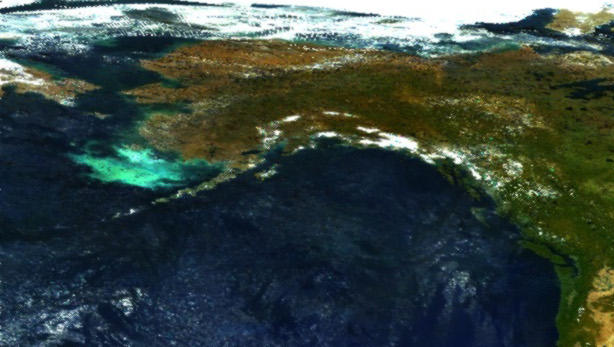Coccolithophore Bloom in the Eastern Bering Sea
Cynthia T. Tynan, Ph.D.
Joint Institute for the Study of the Atmosphere and Ocean
University of Washington
c/o NOAA/AFSC/National Marine Mammal Laboratory
7600 Sand Point Way NE
Seattle, WA 98115-0070, USA
While conducting marine mammal surveys last July along the southeast
Bering Sea shelf, aboard NOAA's R.V. Miller Freeman, we observed an
extraordinary, warm water mass of intense aqua color, which we later learned
was a coccolithophore bloom. The beautiful aqua water
reminded us of a tropical coral reef setting, or a glacially-fed
alpine lake, rather than the Bering Sea. We first encountered
the aqua water on July 19 during a northerly transect along
161 34.6' W. Here we observed streaks or fingers of electric aqua
water interleaving with darker water along a frontal zone. Over the
next 10 days, during our north-south aligned transects on
the shelf, we predictably crossed into and out of the aqua water,
enabling us to map its position and extent.
When approaching the aqua water, the reflection of the intense aqua color
could be seen in the sky above the horizon more than 6 nm away.
On July 29 while heading northward along 167 40.35' W we reached the western
edge of the aqua water, a frontal zone again characterized by interleaving
of aqua and darker bands or fingers. From these observations, we
conclude that by the end of July, the coccolithophore bloom was
approximately 200 km wide, east to west, and still 60 km east of
St. George Island. Our surveys from the flying
bridge will enable us to examine the distributions of cetaceans
(humpback whales, fin whales, right whales, harbor porpoise, Dall's
porpoise, killer whales) and fur seals relative to the productivity
and unique characteristics of the coccolithophore bloom.

True colour
SeaWiFS satellite
image of a coccolithophore bloom off the west coast of Alaska. Provided by
the SeaWiFS Project, NASA/Goddard Space Flight Center.
 NOAA press release
on the die-off of seabirds and other unusual biological and physical conditions in the Bering Sea this summer.
NOAA press release
on the die-off of seabirds and other unusual biological and physical conditions in the Bering Sea this summer.
Ehux
home page
Toby Tyrrell : T.Tyrrell@noc.soton.ac.uk

 NOAA press release
on the die-off of seabirds and other unusual biological and physical conditions in the Bering Sea this summer.
NOAA press release
on the die-off of seabirds and other unusual biological and physical conditions in the Bering Sea this summer.